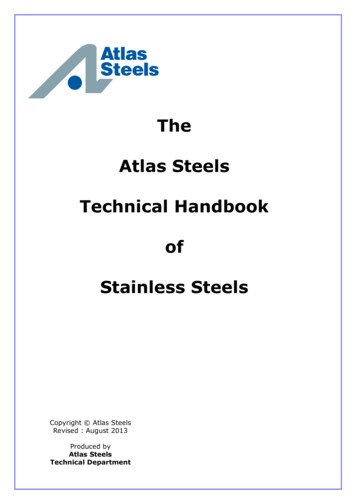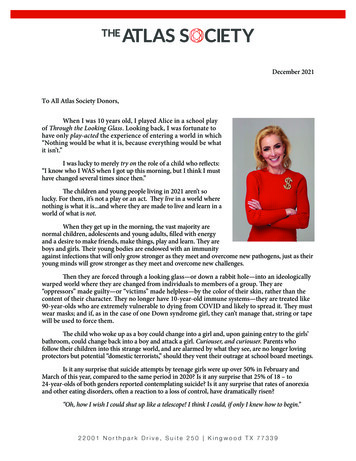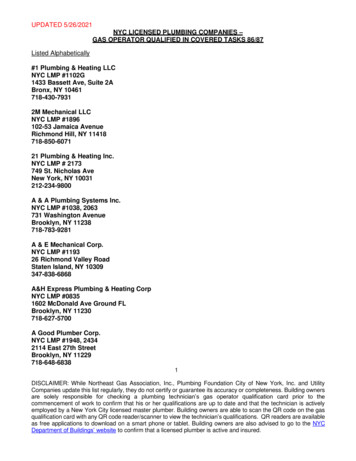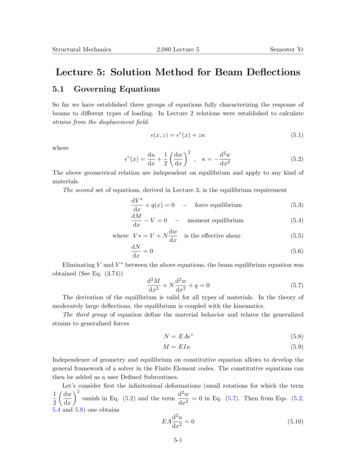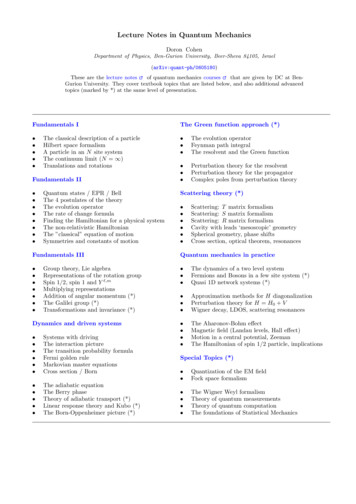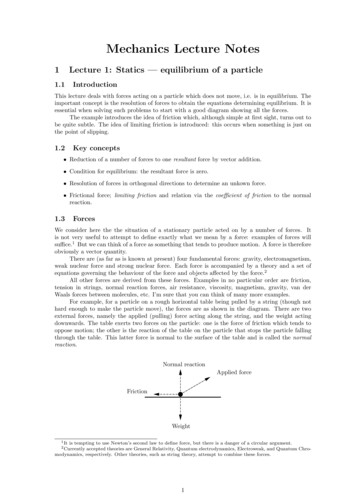
Transcription
Mechanics Lecture Notes1Lecture 1: Statics — equilibrium of a particle1.1IntroductionThis lecture deals with forces acting on a particle which does not move, i.e. is in equilibrium. Theimportant concept is the resolution of forces to obtain the equations determining equilibrium. It isessential when solving such problems to start with a good diagram showing all the forces.The example introduces the idea of friction which, although simple at first sight, turns out tobe quite subtle. The idea of limiting friction is introduced: this occurs when something is just onthe point of slipping.1.2Key concepts Reduction of a number of forces to one resultant force by vector addition. Condition for equilibrium: the resultant force is zero. Resolution of forces in orthogonal directions to determine an unkown force. Frictional force; limiting friction and relation via the coefficient of friction to the normalreaction.1.3ForcesWe consider here the the situation of a stationary particle acted on by a number of forces. Itis not very useful to attempt to define exactly what we mean by a force: examples of forces willsuffice.1 But we can think of a force as something that tends to produce motion. A force is thereforeobviously a vector quantity.There are (as far as is known at present) four fundamental forces: gravity, electromagnetism,weak nuclear force and strong nuclear force. Each force is accompanied by a theory and a set ofequations governing the behaviour of the force and objects affected by the force.2All other forces are derived from these forces. Examples in no particular order are friction,tension in strings, normal reaction forces, air resistance, viscosity, magnetism, gravity, van derWaals forces between molecules, etc. I’m sure that you can think of many more examples.For example, for a particle on a rough horizontal table being pulled by a string (though nothard enough to make the particle move), the forces are as shown in the diagram. There are twoexternal forces, namely the applied (pulling) force acting along the string, and the weight actingdownwards. The table exerts two forces on the particle: one is the force of friction which tends tooppose motion; the other is the reaction of the table on the particle that stops the particle fallingthrough the table. This latter force is normal to the surface of the table and is called the 00000001010101010101010101010101010101010Applied forceWeight1 Itis tempting to use Newton’s second law to define force, but there is a danger of a circular argument.accepted theories are General Relativity, Quantum electrodynamics, Electroweak, and Quantum Chromodynamics, respectively. Other theories, such as string theory, attempt to combine these forces.2 Currently1
1.4EquilibriumA particle or body is said to be in equilibrium when all the forces acting on it balance and it is notin motion. Algebraically, this just means that the vector sum of the forces is zero:XFi 0ior, equivalently, the components of the vectors in three directions (which must be linearly independent, of course, but not necessarily orthogonal) sum to zero.Geometrically, this means that the vectors representing the forces (in both direction andmagnitude) can be joined to form a closed polygon.F1F2F2F3F1F3In order to determine whether a particle is in equilibrium (or, given that it is in equilibrium,to determine an unkown force) we have to check that the vector sum of the forces, i.e. the resultantforce, is zero. That means that the resultant force should have no non-zero component in anydirection. Normally, the way to check this is to check the components of the resultant force in threeindependent directions, which need not be orthogonal but are usually, for convenience, orthogonal.This process is called resolving forces. It can best be understood in a concrete example.ExampleA particle of weight3 W lies on a fixed rough plane inclined at angle α to the horizontal. It is heldin position by a force of magnitude T acting up the line of greatest slope of the plane. Find thefrictional force, F , in terms of W , α and T .Before anything else, we must draw a good diagram showing all the forces. The importanceof a diagram is seen immediately: as soon as we try to draw in the frictional force F we realise thatwe don’t know which way it acts — up or down the plane.As was stated earlier, the frictional force opposes the motion, so if, in the absence of friction,the force T is large enough to pull the particle up the plane, friction acts down the plane. If, in theabsence if friction, the weight is enough to pull the particle down the plane, then friction acts upthe plane. We assume first the former: friction acts down the plane.3 Theweight of the particle is the magnitude of the force it experiences due to gravity; for a particle of mass m,W mg, where g is the (constant) acceleration due to gravity.2
R αWThe strategy for all similar problems is to determine the equations of equilibrium by resolving(i.e. taking components of the vectors) forces in two directions and equating to zero. It helps tochoose the directions carefully in order to reduce the number of terms in each equation.Clearly, for our problem, it is a good plan to resolve parallel and perpendicular to the plane.We have, respectively:T F W sin αR W cos α(1)(2)Thus F T W sin α, using only the first equation.Normally, we are interesting in finding the value of T that will support the particle on theplane. To accomplish this, we have to know something about the frictional force. The experimentalresult relating the frictional force to the normal reactionF µR(3)is generally used. Here µ is the coefficient of friction, the value of which depends on the surfacesinvolved4 . When the equality holds, the friction is said to be limiting.In our example, combining equations (1) and (2) with the experimental law (3) givesT W (sin α µ cos α).Note that in the case of limiting friction, T is determined by this equation.If, instead of assuming that the particle is tending to slip up the plane, we assume that it istending to slip down the plane, then the frictional force would act up the plane. In this case (checkthis!) we findT W (sin α µ cos α)and combining the two results gives the range of values of T for which equilibrium is possible, fora given value of µ:W (sin α µ cos α) T W (sin α µ cos α).Not surprisingly, in order for the particle to remain in equilibrium — i.e. not move — T cannot betoo big or too small.Note that if T were given (for example, if it were the tension in a string that passes over apulley and has a weight dangling on the other end) the above equation would give bounds on thevalues of α allowed for equilibrium.4 Formost common materials, the coefficient of friction lies between 0.3 and 0.6, though it can be considerablyhigher: for silicone rubber on tarmac it is over 1 (which is a good thing).3
Mechanics Lecture Notes1Notes for lectures 2 and 3: Equilibrium of a solid body1.1IntroductionThis lecture deals with forces acting on a body at rest. The difference between the particle of thelast lecture and the body in this lecture is that all the forces on the particle act through the samepoint, which is not the case for forces on an extended body. The important concept, again, is theresolution of forces to obtain the equations determining equilibrium.The simplest examples involve essentially one-dimensional bodies such as ladders. Again, itis essential start with a good diagram showing all the forces.1.2Key concepts Resolution of forces into a single resultant force or a couple. The moment of a force about a fixed point. Condition for equilibrium: zero resultant force and zero total couple.1.3Resolving forcesThe difference between forces acting on a particle and forces acting on an extended body is immediately obvious from the intuitive inequivalence of the two situations below: for an extended body,it matters through which points the forces act — i.e. on the position of the line of action of 1111111111F6 In general, each force acting on a body can be thought of as having two effects: a tendencyto translate the body in the direction parallel to the line of action of the force; and a tendency torotate the body.1 Clearly, for the body to be in equilibrium these effects must separately balance.For the translational effects to balance, we need (as in the case of a particle) the vector sumof the forces to be zero:XFi 0.(1)iFor the rotational effects about a point P to balance, we need the sum of the effects to bezero, but what does this mean? Intuitively, we expect that a force whose line of action is a longway from P to have more rotating effect than a force of the same magnitude that is nearer and itturns out (see below) that the effect is linear in distance. The rotation effect of a force is called themoment of the force.1.4The moment of a forceIn two dimensions, or in three dimensions in the case of a planar body and forces acting in the sameplane as the body, any force tends to rotate the body within the plane or, in other words, about anaxis perpendicular to the plane. In this case, we define:Moment of a force about a point P magnitude of the force the shortest distance between the line of action of the force and P .1 Imaginethat one point, not on the line of action of the force, is fixed.1
with account taken of the direction of the effect: either clockwise or anticlockwise.2In general (in three dimensions when the body and forces are not coplanar), the effect ofdifferent forces will be to tend to rotate the body about different axes. In this case, the ‘force timesdistance from line of action to the point’ definition of the moment of a force is not adequate. Wehave to represent the moment as a vector. The important thing to understand is that the directionof vector representing the moment of the force not in the direction in which the body might move;it is along an axis about which the body might rotate.We can obtain the required vector expression for the moment of a force from a diagram. Inthe diagram below, the magnitude of the moment of the force F about the point P is F d.FdPAs mentioned above, the moment of a force is a vector quantity, the direction of the vectorbeing parallel to the axis through P about which the body would rotate under the action of theforce. This can be very conveniently expressed using the vector cross product:moment of F about P r F(2)where r is the position vector from P to any point on the line of action of F.Why is this cross product the right expression for the moment? Again, we can see from adiagram. The vector r in the diagram below goes from the point P to an arbitrary point on the lineof action of the force. Clearly, r F is in the correction direction (into the paper). And we have r F r F sin θ F dwhich agrees with the 2-dimensional case.FdrθPTo summarise: the magnitude of the moment of a force about a given point is given by therule ‘magnitude of moment equals magnitude of force times shortest distance between line of actionof force and the point’. The vector moment has direction normal to the plane containing the pointand the line of action of the force.For the body to be in equilibrium, we require that there is no tendency to turn about anyaxis. The condition for equilibrium, in addition to (1), is therefore, (in the obvious notation),XX(3)(vector moments of the forces about any point) ri Fi 0iThere will still perhaps be a question mark in your mind about this result: why doesn’t itmatter what point we choose to take moments about? This is easily addressed. Suppose we changethe point from P to P 0 , where the position vector of P 0 with respect to P is a fixed vector a.The position vectors in the condition (3) change from ri to r0i , where r0 i ri a. If we considermoments about P 0 instead of moments about P , we haveXXXXXXr0i Fi (ri a) Fi ri Fi a Fi ri Fi a Fiiiiiiithe vanishing of which is equivalent to the condition (3) provided the equilibrium condition (1)holds.2 In section 1.6, I will explain why the moment of the force, defined like this, is the correct measure of the rotationaleffect of the force; for the time being (and for ever if you perfectly sensibly don’t want to wade through section 1.6)you should just accept that it is what we need.2
1.5CoupleA couple is a pair of equal and opposite forces.3 We define the moment of a couple about anypoint in the obvious way, as the sum of the moments of the two forces about that point. The sumof the moments of two forces will in general depend on the point about which the moment of theindividual forces is taken; but this is not the case for a couple. Let the two forces be F and F,and let r1 and r2 be the position vectors of any fixed points on their respective lines of action, withrespect to a point P . Thenmoment about P r1 F r2 ( F) (r1 r2 ) Fand this does not depend on the choice of P .Choosing P on the line of action of one of the forces shows that the magnitude of the coupleis just F d, where d is the distance between the lines of action of the forces.Fd FExampleA light rod4 of length a stands on rough ground leaning against a smooth wall, and inclined at anangle α to the horizontal. A particle of weight W is placed a distance 23 a up the rod. What is themagnitude of the normal reaction of the wall on the end of the rod?First, as always, a good picture showing all the forces:RFαWThe normal reaction of the ground on the foot of the ladder and the frictional force acting onthe foot of the ladder are combined into a single (unknown) force F, acting in an unknown direction.There is no friction at the upper end of the ladder because the wall is smooth.Before we go any further, we need to sit back and think. We have only three weapons inour armoury: resolving forces in each of two directions of our choosing; and taking moments abouta point of our choosing. If we choose the directions and the point well, we can simplify our taskenormously. In this rather straightforward case, we can eliminate the force that we are not interestedin (the force on the foot of the ladder) in one go by taking moments about the foot of the ladder.Taking moments (‘force times shortest distance from the line of action of the forces to thepoint’) clockwise gives2W a cos α R a sin α 033 Thinkof turning on an old-fashioned tap.the idealisation of the elementary mechanics, rods are straight, rigid and one-dimensional; this one is massless(‘light’).4 In3
so R 32 cot α.We could now, by resolving forces horizontally and vertically, find the horizontal and verticalcomponents of the force on the foot of the ladder, and then the whole problem would be solved.Sometimes it is possible to solve such problems elegantly by geometry (but not necessarilymore easily; you have to be good at geometry). Let us draw the diagram again, this time payingattention to the point at which the lines of actions of the forces intersect.FARαCBWNote first that the three lines of action must intersect. Otherwise, we could take momentsabout the point of intersection of any pair (if not parallel); the two corresponding forces would haveno moment about this point, since their lines of action passes through the point, leaving a non-zeromoment from the third force. The total moment would thus be non-zero and the rod could not bein equilibrium.The triangle ABC can be thought of completely geometrically, in which case it is soluble sincewe know two sides (horizontal and vertical) and the included angle (a right-angle).But the the three forces R, F and W are parallel to the sides of the triangle and, sincethey sum to zero (equilibrium condition) they can be represented as the sides of a triangle. Thistriangle must be similar to ABC, so we can find the relationships between the forces. For example,AC/CB W / R and CB 23 a cos α and AC a sin α so we obtain W in terms of R as before.4
1.6Moment of a force: justification of definitionNB this section is an optional extra: a gigantic footnote5To emphasise the point in the heading: you do not need to know the material in this section; infact, hardly anyone knows it.6However, if you ever ask yourself why the moment of a force is defined as above (i.e. why isthis the appropriate tool for investigating equilibrium), you will find this interesting.We will investigate the resultant of a number of forces acting on a body, which means, as inthe case of a single particle, a reduced system of forces that has exactly the same effect on the bodyas the original system of forces. In the case of a single particle the reduced system is just one force;in the case of a system of forces acting on a body, the reduced system turns out to be a single forceor, in very special cases, a couple.We consider the case of just two forces, F1 and F2 , in two dimensions; the generalisationto more forces in two dimensions is obvious (you just reduce the forces in pairs) and the threedimensional case can be reduced to three two-dimensional cases by looking at the components ofthe forces in, for example, the x-y plane.There are three cases to consider.Case (i) F1 and F2 are not parallelIn this case, the lines of actions of F1 and F2 intersect, at P , say. The resultant, F, of thetwo forces is just F1 F2 and it acts through P .F1 F2F1PF2 PIt is a simple exercise to check that the moment of F about any point Q is the same as thesum of the moments of F1 and F2 about Q.This means that F has the same translational and rotational effect as F1 and F2 combined,provided we use the definition of the moment of a force given in section (1.4).Case (ii) F1 and F2 are parallel, but F1 F2 6 0.In this case, the lines of action of the forces do not act through a common point, so we cannotimmediately use the method above. Instead, the method can be used indirectly through a lovelyconstruction. All we do is to add a pair of equal and opposite forces7 as shown in the diagrams,to give two new forces that are no longer parallel. The diagrams on the next page illustrate theconstruction.The diagrams show:(i) Two parallel forces, F1 and F2 , with F1 F2 6 0 (i.e. exactly the situation we are considering).(ii) In this diagram, two equal and opposite forces, F and F, have been added to the previousdiagram. Adding these forces clearly has no effect: they just cancel each other out.(iii) But if instead of cancelling them out we add them to F1 and F2 , respectively, we obtain tworesultant forces (by Case (i) above) which are the diagonal forces in the diagram.(iv) The forces in (i) are therefore equivalent to the two forces in this diagram.(v) Since the forces in (iv) are not parallel, they can be resolved (by Case (i) above) into a singleforce of magnitude (unsurprisingly) F1 F2 as shown in this diagram. But where does the line ofaction of this resultant lie?(vi) A bit of geometry does the trick. In this diagram, the AB and F G represent in direction andmagnitude the original forces F1 and F2 . CB and EF represent the equal and opposite forces weadded in, and the two resultants are represented by CA and EG. Now using similar triangles gives5 whichI put in because I found it interesting.is not covered in any recent A-level text book that I could find, though it was covered in the book I had atschool, by Humphrey and Topping.7 So simple!6 It5
the magic result DC F1 DE F2 — i.e. the resultant acts through the point where themoments of the original forces balance.F1F1F2F2(ii)(i)FF1 F FF1 FF1F2F2 FF2 F(iii)(iv) FFF1 F2F1 FAF2 F(v)(vi)GBDECHWe thus find that the resultant of the two forces is a single force F1 F2 (unsurprisingly),the line of action of which — and this is the important result — lies at distances d1 and d2 fromthe lines of action of F1 and F2 , respectively, such that d1 F1 d2 F2 ; i.e. so that the momentsof the two forces as defined above are equal.Case (iii) F1 and F2 are parallel, and F1 F2 0.This is the exceptional case, when the system of forces cannot be reduced to a single force.No further reduction is possible and we are left with a couple. It is easy to see that the constructionof Case (ii) breaks down: the construction gives another pair of equal and opposite forces.6F
Mechanics Lecture Notes1Lecture 4: Centre of mass1.1IntroductionThis lecture deals with1.2Key concepts Definition of centre of mass as the point through which the resultant of the gravitationalforces may be considered to act; the point about which the total moment of the gravitationalforces is zero.1.3Centre of massThe centre of mass (or centre of gravity) of a body is the point through which gravity may beconsidered to act. In other words, for the purposes of any calculation involving gravity, we canreplace the solid body with a single massive particle at the centre of gravity; it is as if the mass ofthe body were concentrated at the centre of mass. 1For a one dimensional body (a stick or ladder), the centre of mass is just the point at whichthe body balances, and the same is true of a two-dimensional body (think of a lamina balancing ona pencil point). It is harder to imagine this for a three dimensional body, but you could think of thecentre of mass as being the point such that, for any axis passing through it, there is no tendencyfor gravity to rotate the body about that axis.The following example illustrates the process.Example: the centre of mass of a set of particlesLet n particles be attached to a light straight rod which rests on a smooth pivot, as shown. The ithparticle has mass mi and is distance di from P , the left end of the rod. The pivot is distance d fromone end of the rod. The reaction of the pivot on the rod is R. The system is in equilibrium with therod horizontal.As always, the first move is to draw a good 1010101010di0111111111 001mi gThe blobs in the diagram are the (point!) particles and the ith blob from P , the left end, of therod has mass mi and is a distance di from P .For equilibrium we need the both the forces and their moments (about any point) to balance.Summing the forces givesnXmi g R 0i 1so the reaction of the pivot on the rod is equal to the total weight of the particles — not entirelyunexpected!1 This approach works because the forces of gravity acting on the individual particles of the body are all parallel.A formal proof will be given in Relativity and Dynamics course.1
Summing the moments of the forces about P givesRd nXdi mi g.i 1So, provided we choose the position of the pivot according toPndi mid Pi 1,ni 1 mithe rod and the masses will balance on the pivot just as if it were a single particle of mass equal tothe total mass situated on the pivot.We could of course have taken moments about the pivot to obtain the same result:0 nX(d di )mi g,i 1and had we started from this equation for d we would not have had to involve R at all.1.4Centre of mass: general definitionExtending the above idea to a general system of particles, we define the centre of mass to be at thepoint with position vectorPmrP i i.miThere is an analogous formula for a continuous mass distribution along a one dimensional body (athin rod, say), replacing the sum by an integral and the mass at the point with coordinate x bythe ρ(x)dx, where ρ(x) is the mass density per unit length at that point. Thus the distance of thecentre of mass from the origin (somewhere on the rod, not necessarily at the end) x̄, is given byRxρdxx̄ R.ρdxThe numerator is the moment of the element of mass at x and the denominator is the total mass.We can extend this to three dimensions. The position vector of the centre of mass isRrρ(r)dVRρ(r)dVthough you may not properly understand these volume integrals until the Vector Calculus coursein the Lent term.2
Mechanics Lecture Notes1Lecture 5: Kinematics of a particle1.1IntroductionKinematics1 is the study of particle motion without reference to mass or force. In some ways,studying kinematics is rather artificial: in almost all realistic situations, the motion would have beenproduced by forces and the problem can only be solved by investigating the equations of motionappropriate to the forces acting. The study of motion produced by forces is called Dynamics2 . Notethat we deal with particles, which, by definition, are point-like; they can have mass (though that isnot needed in kinematics) but they have no internal structure, so they cannot, for example, spin.3The example of projectile flight is important, historically and in terms of applications. Fromour point of view, it is a first stab at tackling equations of motion, which is fundamental to alltheoretical physics courses.1.2Key concepts Differentiation of a vector is the same as differentiation of its Cartesian components. Definitions of speed, velocity and acceleration in one and in three dimensions. Formulae for particles moving with constant acceleration in one dimension. Motion of projectiles.1.3NotationMotion on a lineIn one (spatial) dimension, the variables are time, position or distance or displacement from afixed point, speed or velocity, and acceleration. We make a distinction between speed and velocityeven in one dimension: velocity may be positive or negative, corresponding to the particle moving(say) to the right or left; speed is the magnitude of velocity and is therefore always positive or zero.Acceleration can also be either positive or negative.4 We denote time by t, position by x, velocityby u or v and acceleration by a. Sometimes, displacement from the original position of the particleis denoted by s. We might write, for example, x(t) to emphasise that x is a function of time.Velocity, by definition, is rate of change of position, sov dx ẋ .dtThe overdot always denotes differentiation with respect to time.Acceleration, by definition, is rate of chance of velocity, soa dvd2 x v̇ 2 ẍ .dtdtMotion in spaceIn two or three dimensions, time is still t, and the other variables are vector quantities. Wedenote position by r, or sometimes5 x; we might write r(t) to emphasise that the position is afunction of time. Velocity is denoted by u or v and acceleration by a, both vector quantities havingmagnitude and direction (of course).1 From the Greek κινηµα, meaning motion; think of cinema. (I put this in because I thought you might like tosee some Greek letters in words instead of in equations.)2 From the Greek δυναµικoς, meaning powerful.3 At least, not in classical mechanics; in quantum mechanics, particles can have spin — but all sorts of otherstrange things happen in quantum mechanics.4 Even in one dimension, speed and acceleration are vector quantities: they have magnitude and direction, thedirection being either to the left or to the right (say).5 I’m going to use r, because students say that they can’t tell the difference between my handwritten x and mymultiplication or vector product sign .1
With respect to an origin and in standard Cartesian axes, we write xr y zor, to save space, just (x, y, z).Velocity, by definition, is rate of change of posit
Mechanics Lecture Notes 1 Notes for lectures 2 and 3: Equilibrium of a solid body 1.1 Introduction
